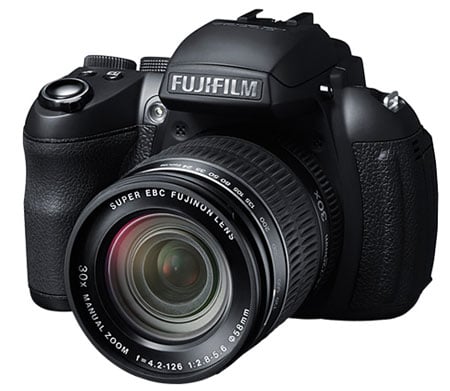Fujifilm FinePix HS30 EXR review
-
-
Written by Ken McMahon
Verdict
The Fujifilm FinePix HS30 EXR is a 16 Megapixel super-zoom with a 30x stabilised lens, a high-resolution electronic viewfinder and a 3in flip-up screen. It replaces the FinePix HS20 EXR which, on the surface, looks nearly identical and shares similar specifications, but there are a number of crucial differences.
First, there’s a redesigned sensor offering improved low light performance. A bigger, higher resolution viewfinder outperforms anything the competiton has to offer and the LCD screen has been upgraded to provide excellent performance outside in bright conditions. The HS30 EXR replaces its predecessor’s AA batteries with a proprietary Lithium Ion battery providing enough power for 600 shots.
There’s no change to the video specifications, with the best quality 1080p30 mode retained along with fully automatic exposure control for movie shooting, but creative control has been extended, at least to focussing, with the addition of manual focus and face tracking during movie recording. A raft of other small improvements includes faster startup, an electronic level gauge, a programmable custom function button and ‘intelligent’ digital zoom.
 |
Compared to Sony Cyber-shot HX200V
The Sony Cyber-shot HX200V matches the FinePix HS30 EXR for zoom range, but its stabilised 30X optical zoom starts with a narrower 27mm equivalent focal length and extends 90mm further to 810mm, so if it’s reach you’re looking for, the HX200V will get you closer to your subject. Both cameras have a 3in articulated screen hinged in an almost identical fashion. Though the HX200V’s has a higher resolution 921k dot screen, the HS30 EXR’s is much easier to see outdoors in bright light. Switch to the electronic viewfinder and the HS30 EXR provides a bigger brighter more detailed view.
The HS30 can shoot RAW, has an abundance of physical controls, a manually operated zoom barrel and a hotshoe for mounting an external flash, all things which might endear it more to those looking for SLR-style handling
The HX200V on the other hand is smaller, lighter and arguably better looking than the HS30 EXR. It has a motorised zoom which is more useful for movie shooting plus you can manually zoom (via a motorised coupling) if you want. Though it lacks the HS30 EXR’s RAW mode and its eponymous shooting modes, it has plenty of its own including Hand-held Twilight, panorama, 3D modes, and a range of Photo Creativity options. It also features a built-in GPS reciever that tags your images with the current geographic location.
The HX200V also provides superior movie modes with a best quality 1080p50/60 mode, with the option of AVCHD or MPEG-4 encoding. Finally, the HX200V has a higher resolution 18.2 Megapixel CMOS sensor, but my test revealed that the overall quality and low light performance of the HX200V wasn’t quite as good as the 16 Megapixel FinePix HS30 EXR.
See my Sony HX200V review for more details.
Compared to Panasonic Lumix FZ150
The Panasonic Lumix FZ150 has a 24x stabilised optical zoom with a range extending from a wide 25mm (almost as wide as the 24mm of the HS30 EXR) to 600mm. Its 3in screen is the same resolution as the HS30 EXR’s but isn’t quite as easy to view in bright conditions and its EVF is smaller, not so bright and less detailed. On the upside, the screen is hinged at the side which means it can face in any direction including forwards.
Both cameras can shoot RAW and both have a hotshoe, but the FZ150 has a socket for an external mic which can also be used with a remote / intervalometer. The FZ150 also offers a best quality 1080p50/60 (region dependent) video mode as well as full resolution continuous shooting with a 12-frame burst at 12fps compared with an 8 frame 8fps burst on the HS30 EXR.
Then there’s image quality. In my real-life resolution and high ISO noise tests, the FZ150’s 12.1 Megapixel sensor came out on top. One last thing to consider is that Panasonic has recently launched two newer super-zoom models, the FZ60 / FZ62 and FZ200.
See my Panasonic FZ150 review, Panasonic FZ60 / FZ62 review and my upcoming Panasonic FZ200 review for more details.
Fujifilm FinePix HS30 EXR final verdict
The Fujifilm FinePix HS30 EXR is, like it’s predecessor, a super-zoom with its own very distinctive character and style. The specifications put it on a par with market-leading models from other manufacturers, but they really only tell part of the story. To really appreciate its qualities, you need to hold the FinePix HS30 EXR in your hand.
The things that mark it out are its rugged hefty construction, abundance of physical controls, its mechanically-coupled manual zoom and the unique EXR modes. Fujifilm has augmented those features with a redesigned sensor, hugely improved electronic viewfinder and LCD screen, and enhanced movie shooting. It’s still not a camera everyone will love, as ease of use isn’t one of its strengths and if you want to make the most of its pixel-combining EXR modes you’ll have accept a drop in image size to 8 Megapixels. But If you’re comfortable with physical controls and prefer to be given the option to experiment with a variety of shooting modes, some of them unique, you won’t be disappointed. I wasn’t and I have no hesitation in recommending it.
Bad points | Scores (relative to 2012 super-zooms) |
 | ||
Build quality: Image quality: Handling: Specification: Value:
Overall: |
17 / 20 17 / 20 16 / 20 17 / 20 16 / 20
83% | |||






